The powder measure.......
Feb 27, 2009 16:14:48 GMT -5
Post by Richard on Feb 27, 2009 16:14:48 GMT -5
There was a recent thread about powder measures (drop measures) and their reliability in throwing consistent charges. A number of shooters were wary and felt weighting charges was the only way to go. Being a benchrest shooter, both short range (100, 200 and 300 yds) and long range (600 and 1,000 yards), I know the benefits of precision charging for both disciplines. In short range competition, very, very exact charges are not critical to not only good accuracy, but verticle dispersion. There is an article written in a Precision Shooting “Bible so to speak” where two highly acclaimed shooters performed a test. They took a load for the famed 6mm PPC cartridge and shot it from a known very good shooting Pac-Nor barrel. They shot a one hole “tiny” group at a certain powder weight and then proceeded to add a “click” (tenth of a grain or so) on their CULVER style powder measure. With each click, they fired a shot. It took about five clicks before the group started growing vertically and then, ever so little. This shows that a tenth or two or three will not open up the group. And that, with a highly precision rifle shot by experts.
On the contrary, the long range shooter is not allowed that leeway in putting together his loads. The difference? At 600, but more so at 1,000 yards, those few tenths of grain of powder relate to differences in MV which will cause a lot of vertical dispersion. So, in the long range game, every little thing the shooter can do to make each load as exact as the next, is critical, hence, weighting charges to the exact “kernel” can provide better results on the target.
The above leads me to this little blog, so to speak, on powder measures and their reliability. First let me say I am not a spokes person for Harrell’s powder measures. I bought the one I have over ten years ago. The only other things I buy from Lynwood Harrell is his muzzle brakes and extra plastic bottle.
As you can see from the pictures, I have a number of powder measures as well as the RCBS Chargemaster and two RCBS 10/10 powder scales. (One is packed in my reloading range box)
For all my 600 and 1,000 yd. loading, I use the Chargemaster exclusively. I love it! For my short range and varmint loadings, I use my drop measures. The Harrell’s, of course, is my favorite. I say this because of its construction and the “guts”. This measure is a clone, so to speak, of the famous (in benchrest circle) Lyman/Culver measure. As you can see, I also have two Lyman measures (not Lyman/Culver’s). Homer Culver was a shooter, tinkerer who devised a new set of “guts” for the Lyman measure. If you look at the brass gut for my Harrell’s measure, you wil get an idea of what I mean. The measure has stops or “clicks” as you turn it. (Like the turrets on a Nightforce scope). There is actually a “ball detent” that audibley clicks to each position. Looking at the side of the measure you will notice five (what looks like) black marks. Eash is a set screw which locates the detent. So, you set your measure up so the distance inbetween numbers is anywhere from one to five little clicks. In other words, you can move from say 50 to 51 with five “little clicks” in between. I might have a load that wants the measure set at 50.3? With a measure like this, it is simple to screw on a bottle of H-4198, set the measure for 100.3, vigorously tap and shake the measure to settle the powder, then throw three or four charges drop them back in the “bottom” of the bottle (which has a convenient plug) Then, throw the fifth in the pan, put it on the scale and verify the load. For the purposes of this article, I did just that.
I threw 10 charges and weighted each. Five of the ten were dead nuts on, two were .2 off and three were .1 off. With that being said, I find it hard to believe that one or two tenths of a grain in muzzleloader will show up on your chronograph or on the target. I have found too many other things which will cause velocity differences. Mainly the bullet, the sabot, the barrel, the temperature of the barrel. Probably approaching .5 grain will show some differences.....maybe?
I use the two Lyman’s to throw small charges of N 110 and 5744 (they are set for ten gr. each)
The big RCBS and the Redding measures are used for throwing larger charges of powder. The Harrell’s model that I have will only throw up to about 62 gr. Of H-4198. As you can see from the picture I took from my Sinclair International catalog, Harrell’s has several different types for different disciplines. The one for pistols will only throw up to 25 gr. The Redding, Lyman and RCBS have micrometer typ adjustments but are a pain in the butt to read and are a lot more trouble to use. I can switch powder bottles with my Harrell’s measure in a snap and I am totally confident that the charges will be as exact as I need.
So, while I have an accurate and fairly quick RCBS Chargemaster, I opt for the Harrells when loading charges for the ML or smaller capacity cartridges that use short grained or ball powders. As you can see, I have five vials in my hand. In a matter of less than ten seconds, I can have them all charged up. So, don’t be too quick to sell the “drop measures” short.
Richard
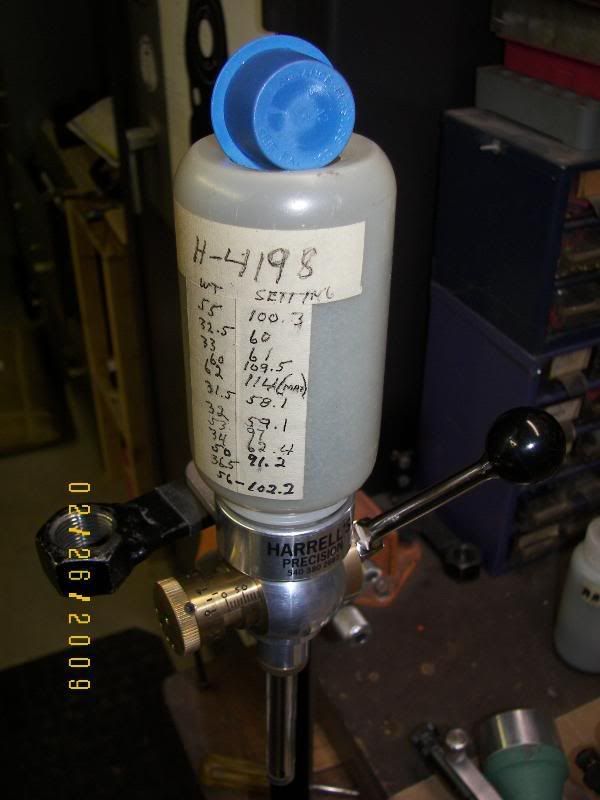
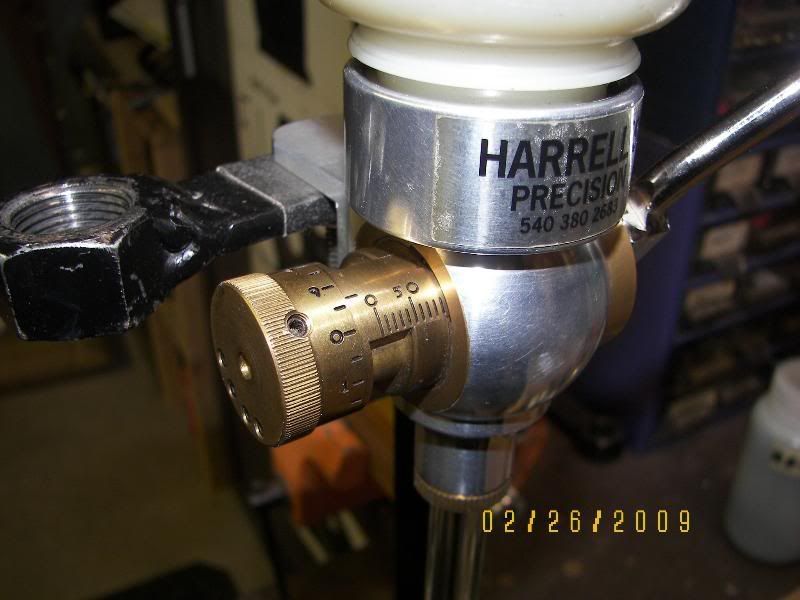
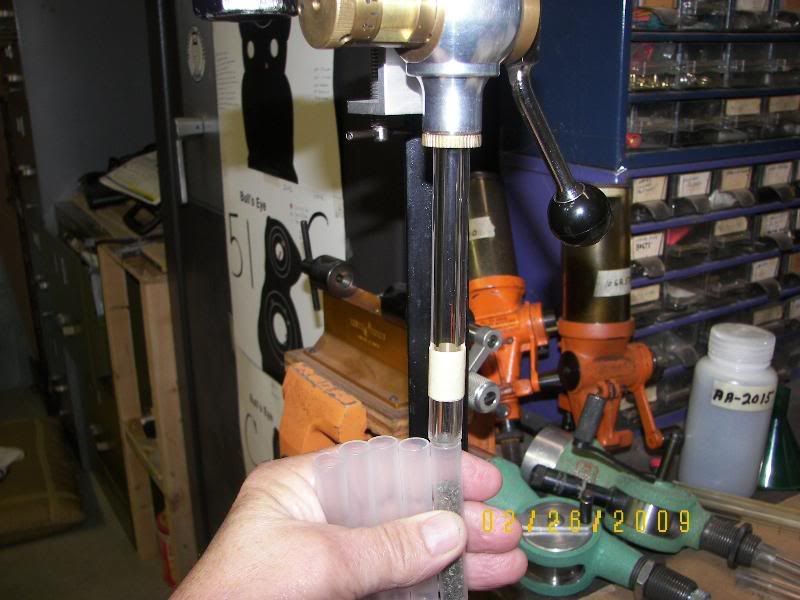
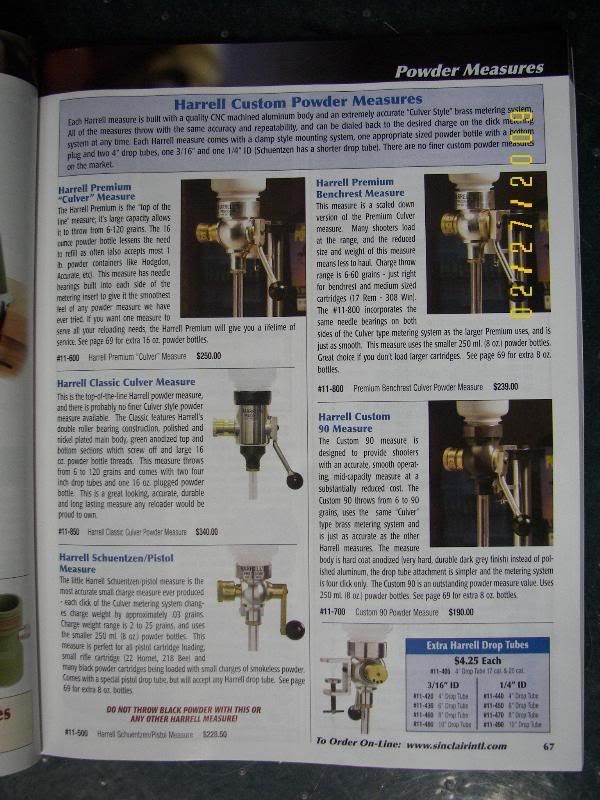
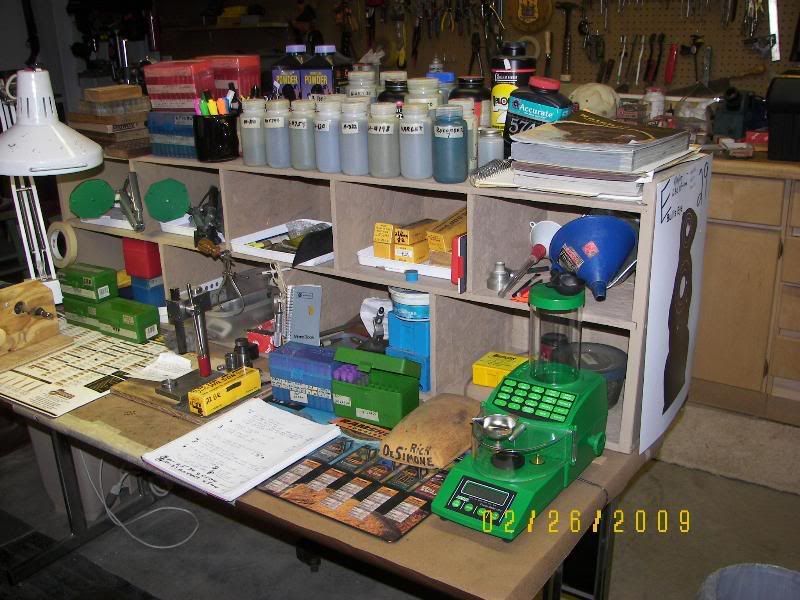
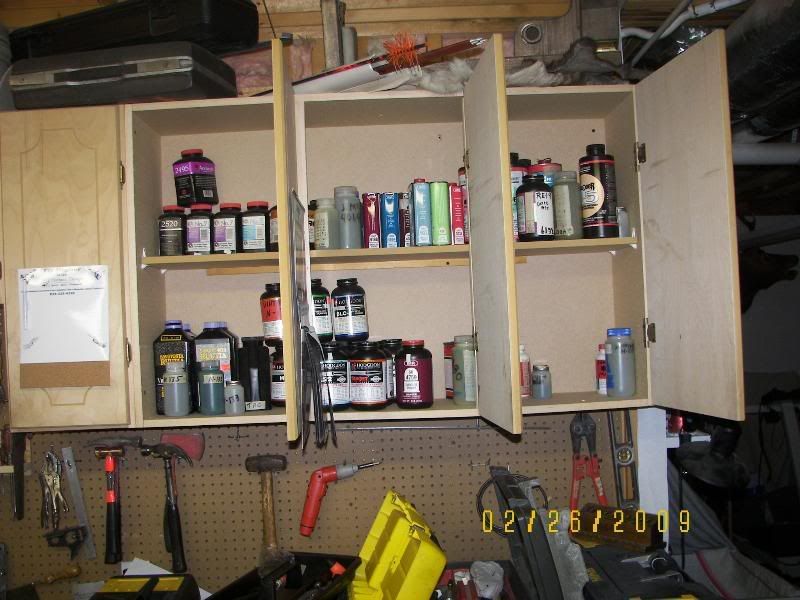
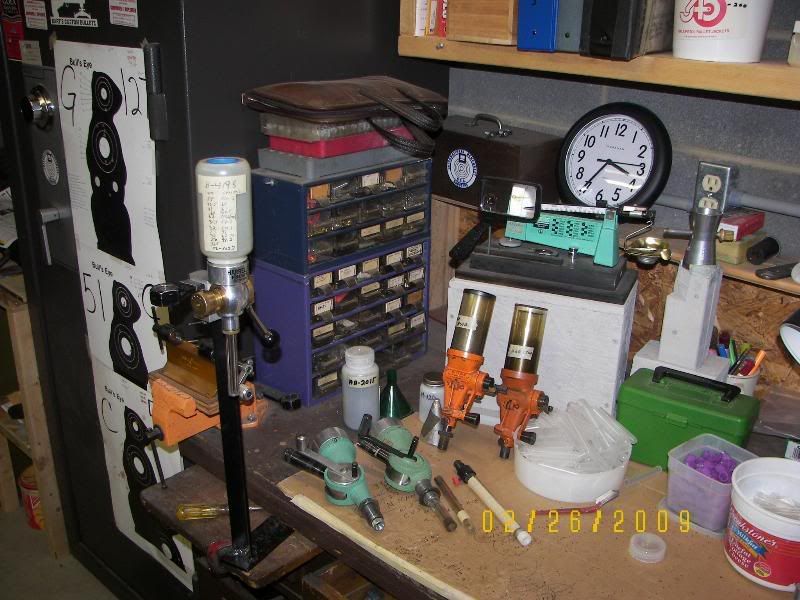
On the contrary, the long range shooter is not allowed that leeway in putting together his loads. The difference? At 600, but more so at 1,000 yards, those few tenths of grain of powder relate to differences in MV which will cause a lot of vertical dispersion. So, in the long range game, every little thing the shooter can do to make each load as exact as the next, is critical, hence, weighting charges to the exact “kernel” can provide better results on the target.
The above leads me to this little blog, so to speak, on powder measures and their reliability. First let me say I am not a spokes person for Harrell’s powder measures. I bought the one I have over ten years ago. The only other things I buy from Lynwood Harrell is his muzzle brakes and extra plastic bottle.
As you can see from the pictures, I have a number of powder measures as well as the RCBS Chargemaster and two RCBS 10/10 powder scales. (One is packed in my reloading range box)
For all my 600 and 1,000 yd. loading, I use the Chargemaster exclusively. I love it! For my short range and varmint loadings, I use my drop measures. The Harrell’s, of course, is my favorite. I say this because of its construction and the “guts”. This measure is a clone, so to speak, of the famous (in benchrest circle) Lyman/Culver measure. As you can see, I also have two Lyman measures (not Lyman/Culver’s). Homer Culver was a shooter, tinkerer who devised a new set of “guts” for the Lyman measure. If you look at the brass gut for my Harrell’s measure, you wil get an idea of what I mean. The measure has stops or “clicks” as you turn it. (Like the turrets on a Nightforce scope). There is actually a “ball detent” that audibley clicks to each position. Looking at the side of the measure you will notice five (what looks like) black marks. Eash is a set screw which locates the detent. So, you set your measure up so the distance inbetween numbers is anywhere from one to five little clicks. In other words, you can move from say 50 to 51 with five “little clicks” in between. I might have a load that wants the measure set at 50.3? With a measure like this, it is simple to screw on a bottle of H-4198, set the measure for 100.3, vigorously tap and shake the measure to settle the powder, then throw three or four charges drop them back in the “bottom” of the bottle (which has a convenient plug) Then, throw the fifth in the pan, put it on the scale and verify the load. For the purposes of this article, I did just that.
I threw 10 charges and weighted each. Five of the ten were dead nuts on, two were .2 off and three were .1 off. With that being said, I find it hard to believe that one or two tenths of a grain in muzzleloader will show up on your chronograph or on the target. I have found too many other things which will cause velocity differences. Mainly the bullet, the sabot, the barrel, the temperature of the barrel. Probably approaching .5 grain will show some differences.....maybe?
I use the two Lyman’s to throw small charges of N 110 and 5744 (they are set for ten gr. each)
The big RCBS and the Redding measures are used for throwing larger charges of powder. The Harrell’s model that I have will only throw up to about 62 gr. Of H-4198. As you can see from the picture I took from my Sinclair International catalog, Harrell’s has several different types for different disciplines. The one for pistols will only throw up to 25 gr. The Redding, Lyman and RCBS have micrometer typ adjustments but are a pain in the butt to read and are a lot more trouble to use. I can switch powder bottles with my Harrell’s measure in a snap and I am totally confident that the charges will be as exact as I need.
So, while I have an accurate and fairly quick RCBS Chargemaster, I opt for the Harrells when loading charges for the ML or smaller capacity cartridges that use short grained or ball powders. As you can see, I have five vials in my hand. In a matter of less than ten seconds, I can have them all charged up. So, don’t be too quick to sell the “drop measures” short.
Richard










